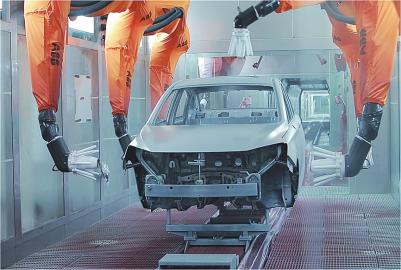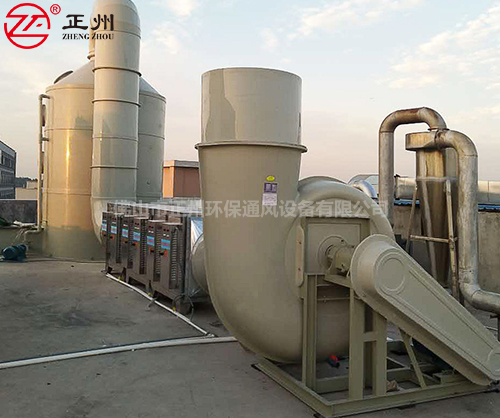VOCs emission sources mainly include industrial sources, domestic sources and mobile sources.
Among them, industrial sources are the main emission sources, with an emission contribution rate of up to 55.5%.
The industrial painting process is an important part of the industrial sources of VOCs, and its emissions account for more than 20% of the whole industrial sources.
Whereas industrial painting involves a wide range of industries, including automobile manufacturing and repair, ship manufacturing, container manufacturing, furniture manufacturing, communication equipment and other electronic terminal products manufacturing, general equipment manufacturing, special equipment manufacturing and electrical machinery and equipment manufacturing.
Large emissions of VOCs, and emissions rich in aromatic hydrocarbons and oxygenated organic compounds and other photochemically reactive and toxic substances, which have a greater impact on air quality.
In addition, the proportion of industrial painting using solvent-based paints is as high as 75%, controlling upstream paint products, with great potential for emission reduction.
- Common VOCs waste gas treatment methods in the coating industry
At present, the common VOCs waste gas treatment methods include: combustion, adsorption, condensation, chemical oxidation, low-temperature plasma, photocatalytic oxidation and biodegradation, etc.
In the “Guide to feasible technologies for pollution prevention in the painting industry” issued by the Ministry of Ecology and Environment, adsorption, combustion, condensation or a combination of these processes are recommended for treatment.
In the actual application process, the process can be reasonably selected according to the actual pollution production of the enterprise and the matching of the project by the enterprise.
- The painting industry waste gas treatment project examples
1、Project overview
An automobile trim painting process uses a lot of organic solvents in the production process, and the pollutants are mainly organic pollutants generated by the volatilization of paints and solvents, the main components are ethyl acetate and benzene (toluene, xylene, etc.). The original use of cellular activated carbon adsorption equipment for purification treatment, due to the low efficiency (about 60%) and adsorption saturation need to regularly replace the cellular activated carbon, the generation of hazardous waste also need to deal with; this environmental protection equipment to upgrade and transform, replace a new set of purification equipment.
2、Introduction of waste gas treatment process
The working process of this device can be divided into 4 process sections, washing tower, dry filtration stage, activated carbon adsorption stage, activated carbon desorption regeneration stage.
(1) Scrubber tower
The exhaust gas from the workshop enters the scrubber tower device. When the organic exhaust gas passes through the scrubber tower, the particulate matter (paint mist) in the exhaust gas can be effectively intercepted by the water mist and environmental protection balls in the scrubber tower, and the gas components and particulate matter components are separated and enter the lower processor for processing.
(2) Dry filtration stage
After the exhaust gas from the workshop enters the scrubber, the organic exhaust gas still contains water mist and trace paint mist, so the water mist is removed by the water baffle and mist eliminator in the dry filtration device, and then the trace paint mist is intercepted by the primary effect and bag filter, and the gas and particulate components are separated again and enter the next stage processor for processing.
(3) Activated carbon adsorption stage
When the organic waste gas passes through the activated carbon layer, the organic components in the waste gas are attracted to the micro-pores of the activated carbon and remain concentrated therein, so that the organic components are separated from their components and the other components (clean gas) are exhausted by the fan.
(4) Activated carbon regeneration stage
Activated carbon is used for a period of time, after adsorption of a certain amount of solvent, because the adsorption amount gradually increases will reduce or lose adsorption capacity, then the activated carbon needs to desorption regeneration, regeneration of activated carbon to regain adsorption function, activated carbon can continue to use. When regeneration, the combustion chamber is warmed up by preheating, and when the temperature reaches the starting temperature, it is switched to desorption route for desorption and regeneration of the activated carbon adsorption box.
- Project design
1、Exhaust gas volume and treatment description
According to the feedback of the original equipment and collection effect, the exhaust volume of the printing production line is about 40,000m³/h. According to the statistics of the original exhaust pipe testing data, the concentration of VOCs at the inlet of the exhaust gas treatment equipment is about 100-300mg/m³.
2、Exhaust gas emission standard
The emission standard of project exhaust gas executes DB33/2146-2018 “Emission Standard of Air Pollutants for Industrial Painting Process” emission standard regulations.
The emission requirements are as follows: total non-methane hydrocarbons (ethyl acetate, etc.) ≦40mg/m³, emission rate ≦1.5kg/h.
3、Exhaust gas treatment process
The painted exhaust gas enters the washing tower, dry filtration equipment, and then passes through the adsorption treatment of activated carbon adsorption box 1,2,3, and the treated exhaust gas is discharged through the adsorption fan and exhaust pipe.
At this time, the catalytic combustion furnace is preheated, and when the catalytic ignition temperature of ethyl acetate reaches 260℃, the corresponding valve and desorption fan are opened.
The air is heated to about 100°C by the heat exchanger to desorb the activated carbon adsorption tank 4, and the desorbed exhaust gas enters the electric heater of the catalytic combustion furnace and is heated to a starting temperature of 260°C. The catalytic combustion reaction forms carbon dioxide (CO2) and water vapor (H2O).
The combusted exhaust gas is recovered by heat exchanger and then discharged to the exhaust pipe (chimney) by desorption fan.
- Exhaust gas treatment equipment composition
(1) Dry filter box. The maximum air volume is 40,000m³/h, the size is 4.15m*2.57m*2.04m, built-in water baffle and mist eliminator, two filtration devices, primary filtration G4 and bag filtration F8, the production workshop is a clean workshop, the main purpose of this equipment is to remove the dust particles (paint mist) that may enter the exhaust gas pipeline, to prevent blocking the activated carbon adsorbent, affecting the adsorption effect. effect.
(2) Activated carbon adsorption box. Fixed-bed activated carbon adsorption is used, with a single treatment capacity of 13,333m³/h and three suction and one removal. Activated carbon filling quantity is 1.2m3/box, gas through the activated carbon speed is about 0.2m/s, residence time is about 1.5s. 24h per day adsorption up to all-day operation, carbon box regeneration cycle is 1 ~ 1.5h. carbon box using 80K rock wool for insulation.
(3) catalytic combustion equipment. The maximum processing air volume is 1,333m³/h, including a set of heat exchanger, filtration chamber, combustion heating chamber (containing electric heater, catalyst), temperature detector, etc. The catalytic bed catalyst air speed is 10,000h-1, and the concentration of the exhaust gas entering the catalytic bed is about 500 to 1,500mg/m³, depending on the spraying condition. The equipment is insulated with ceramic wool and rock wool.
(4) Piping. The pipe is made of galvanized material, and the pipe between the catalytic bed and the activated carbon adsorption equipment is insulated with glass wool material and covered with galvanized sheet.
(5) Fans. This system contains 2 groups of fans, all using frequency control; respectively, 1 adsorption main fan (air volume Q=40,000m³/h, air pressure P=1,800Pa, power N=45KW) and 2 desorption combustion fans (air volume Q=1,333m³/h, air pressure P=2,500Pa, power N=3.7KW).
(6) Electric control system. The system uses a large number of pneumatic valves totaling 18, 4 solenoid valves for fire fighting, 7 thermometers, and 1 set of fixed VOCs sensor detector to realize the automatic operation of the system, and all operations are fed back to the operation screen through PLC, while the operation sub-screen is set up in the workshop to facilitate the operation.
(7) Safety system. The system catalytic bed and activated carbon adsorption equipment installed between the fire dampers, pipeline installation explosion relief door, activated carbon adsorption tank configuration pressure relief valve and fire water extinguishing device. In the use of VOCs sensor automatic control at the same time set other safety redundancy measures.
- Operation results
1、Pollutant monitoring data
After the normal operation of the project, the equipment was monitored for several weeks at different operating hours and a local third-party certified company was commissioned to test the import and export VOCs concentration indicators using a standardized detector. The effect of removal rate of non-methane total hydrocarbons reached over 90%.
2、Investment and operation cost
The project investment is mainly equipment and installation of activated carbon adsorption equipment, filters, fans, catalytic combustion beds, ventilation ducts, desorption combustion ducts, automatic control system, etc. The total investment of the project is about 1.9 million RMB. The system operation cost is mainly on the equipment consumption of electricity, processing waste gas volume 40,000m³/h, 24h per day. electricity consumption is about 120KW*h, the electricity price is 1.0 yuan / (KW*h), that is, the electricity cost of processing 1m³ waste gas is 0.003 yuan.
- Conclusion
After the upgrading and transformation of the exhaust gas treatment facilities, the overall removal rate is above 90%, and after it was put into use in 2018, the pollution emission of this auto trim painting exhaust gas has been significantly reduced, and the environmental odor of the plant has been significantly improved, and there is no odor complaint incident at present.
Post time: Oct-21-2022


